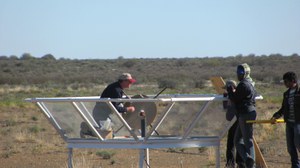Hydrogen Epoch of Reionization (HERA) - Precision Array for Probing the Epoch of Reionization (PAPER)

Senior Research Engineer Rich Bradley instructs South African students on instrument operation and assembly during the 64-element PAPER deployment in the Karoo region of the Northern Cape (July 2011).
Characterizing “Cosmic Dawn”—the emergence of the very first stars and their host galaxies from the fabric of the largely featureless infant Universe—is one of the key scientific goals recommended by NWNH. The Hydrogen Epoch of Reionization Arrays (HERA) road map presented to the Survey one strategy for reaching that goal, proposing to build out a staged sequence of increasingly powerful radio arrays to unveil and model, in increasing detail, the physical processes that led to the contemporary Universe. The road map was strongly endorsed by NWNH, in part because of its scientific focus, and in part because it is to be heavily leveraged through partnerships that build upon existing world-class radio astronomical infrastructure. As part of its core development activities, NRAO will continue to participate as a major institutional partner in HERA and will continue to devote its scientific, technical and managerial expertise to ensure the success of the HERA program. PAPER, the Precision Array for Probing the Epoch of Reionization, a partnership between NRAO staff scientists and scientists at UC-Berkeley, the University of Virginia, the University of Pennsylvania, and SKA South Africa, is one of two HERA-I class instruments currently under development. PAPER has completed its expansion to a 64-telescope array at its South African site and has been awarded funding from the NSF to expand this to a 128-element array in an attempt to detect of an EOR signature. The NRAO will continue its expansion of the PAPER experiment in South Africa and commence observations attempting to detect the EoR signature.




Connect with NRAO